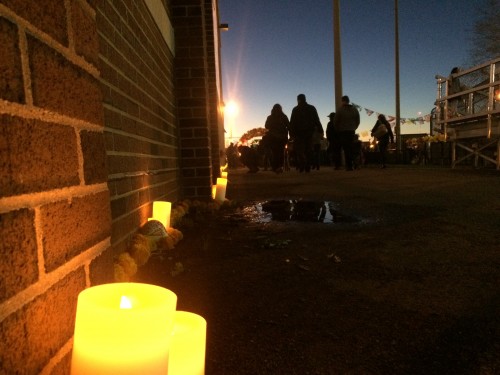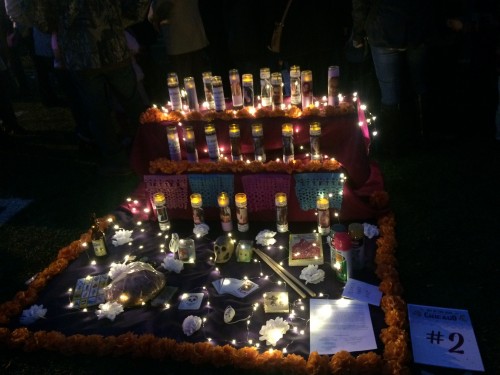
Altars color the streets in a warm orange glow of candles and marigolds. Calacas on stilts make their way gently through the crowds while the faces of children tilt upwards eagerly in awe of the skeletons toothy grins, lustrous gold suits and dramatic top hats. The altars in the distance look like stars littered over the ground, shimmering as bodies pass in front of the candles blazing brightly in honor of those no longer here to celebrate today.
Barbara G. Engelskirchen, Chief Development Officer at the National Museum of Mexican Art, worked to make this outdoor spectacle a reality in Harrison Park in Pilsen for Dia de los Muertos. An exhibition runs at the museum through Dec. 13.
“Every year for the past 30 years we have done a Day of the Dead exhibition inside the museum but this is first time ever doing it outside and on this large scale,” Engelskirchen said.
With two main projections taking up the entire outside of the museum, the display is massive. One of the projections shows an animated depiction of the story of Day of the Dead, a tradition that dates back to the Aztecs. The images filling the screen are of ofrendas, the beautiful La Calavera Catrina, pan de muerto and calacas de azúcar. These are all prominent parts of celebrating the lives of the dead and honoring their memories. The other projection is a community ofrenda, or community altar.

“People have submitted photos of loved one that have passed away that we are projecting, made possible by a grant we received from the Department of Cultural Affairs and Special Events to be able to do this,” Engelskirchen said.
Samuel and Linda Gamboa, built an altar to honor Samuel’s late father. Sitting on top of the bright wrapping papers is a worn baseball cap, his favorite concha bread and loud music filling all the space around the altar with mariachi.
“Most importantly we included tequila,” Lisa Gamboa said, laughing.
This is the first year the Gamboas are celebrating Dia de los Muertos to commemorate the life and legacy of Samuel’s father who died this year.
The altars are a collection of personal items, beloved foods, drinks, flowers and anything else that encapsulates the life of the person it honors.
“It is hard looking at all his favorite things,” Samuel Gamboa said.
“And even harder listening to the songs he used to sing, he loved his music,” Lisa Gamboa said.
Recently moved from Southern California to Chicago, Luis Lopez-Maldonado found a way to celebrate Dia de los Muertos as soon as he stepped foot into the city. In elaborate face paint he spun in front of his alter, in a flurry of constant motion.
“I’m calling it a moving ofrenda, which is basically embodying memory and making improvised choreography on the spot to honor my grandparents, cousin and uncle that have passed over the last 10 years.”
“La Muerte Niña: Day of the Dead”
National Museum of Mexican Art
1852 W. 19th St.
Open through Dec. 13
The museum will also host Dia de los Muertos Ball: Love Never Dies on Dec. 6 to raise funds for its educational department.

